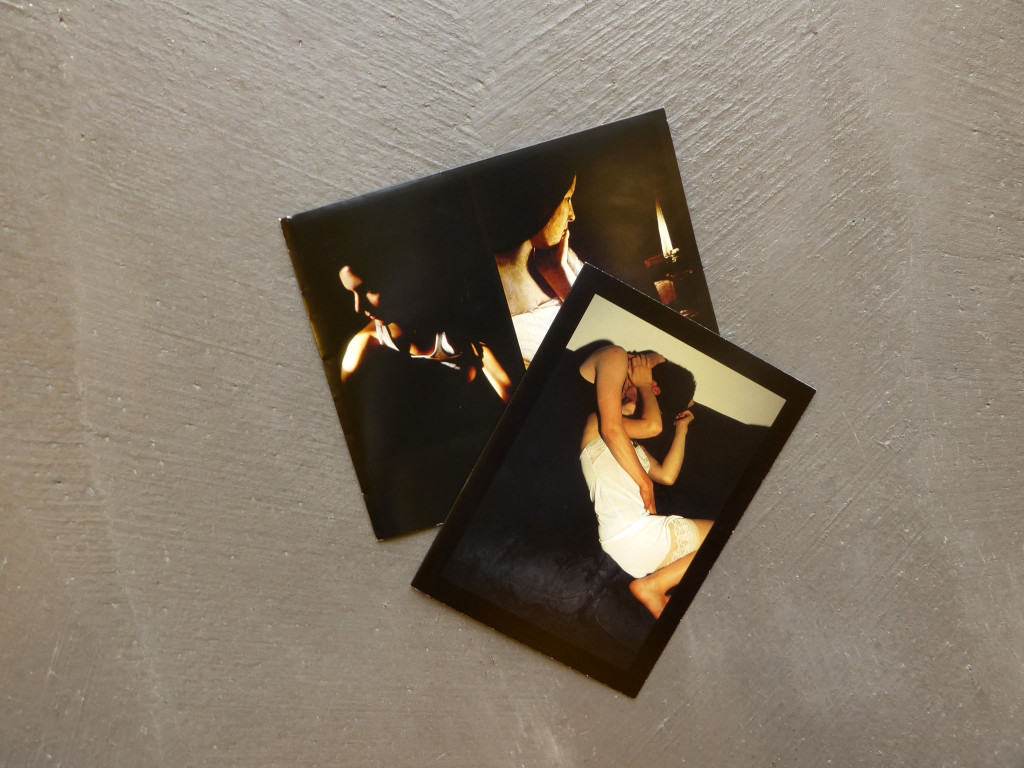
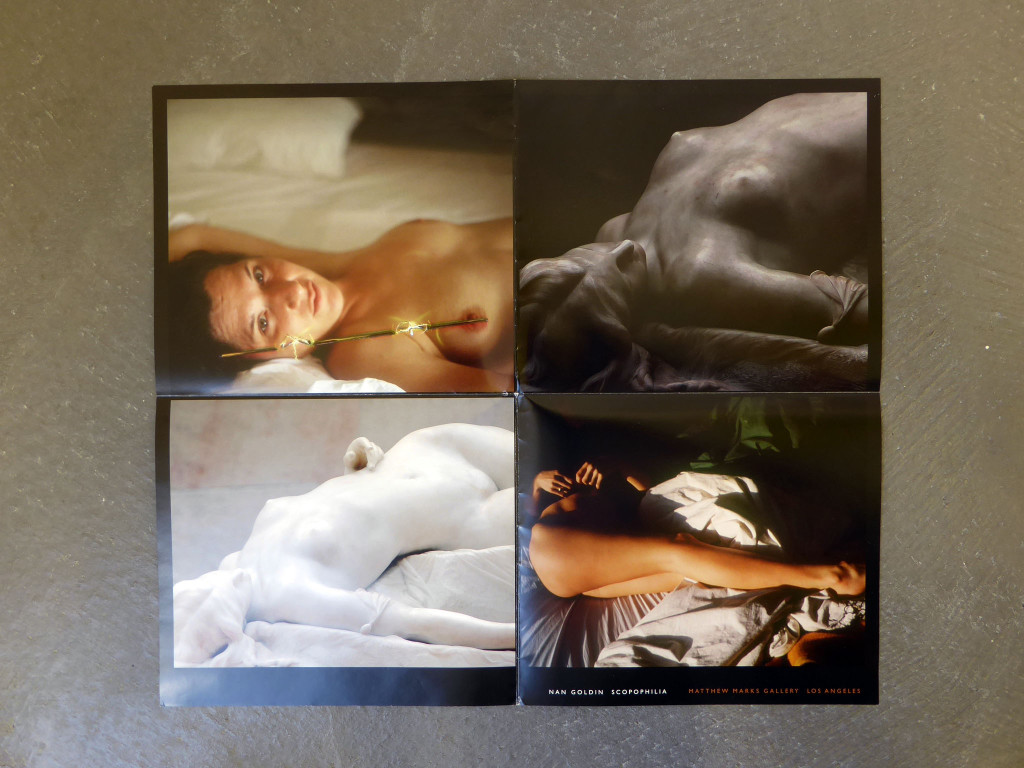
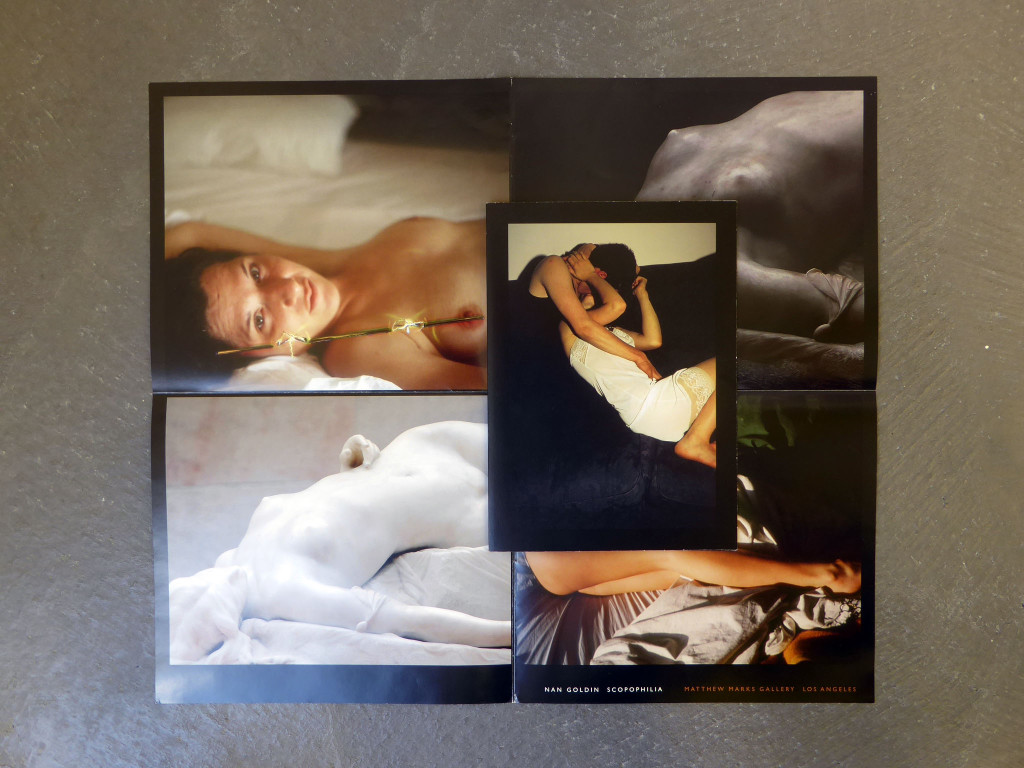
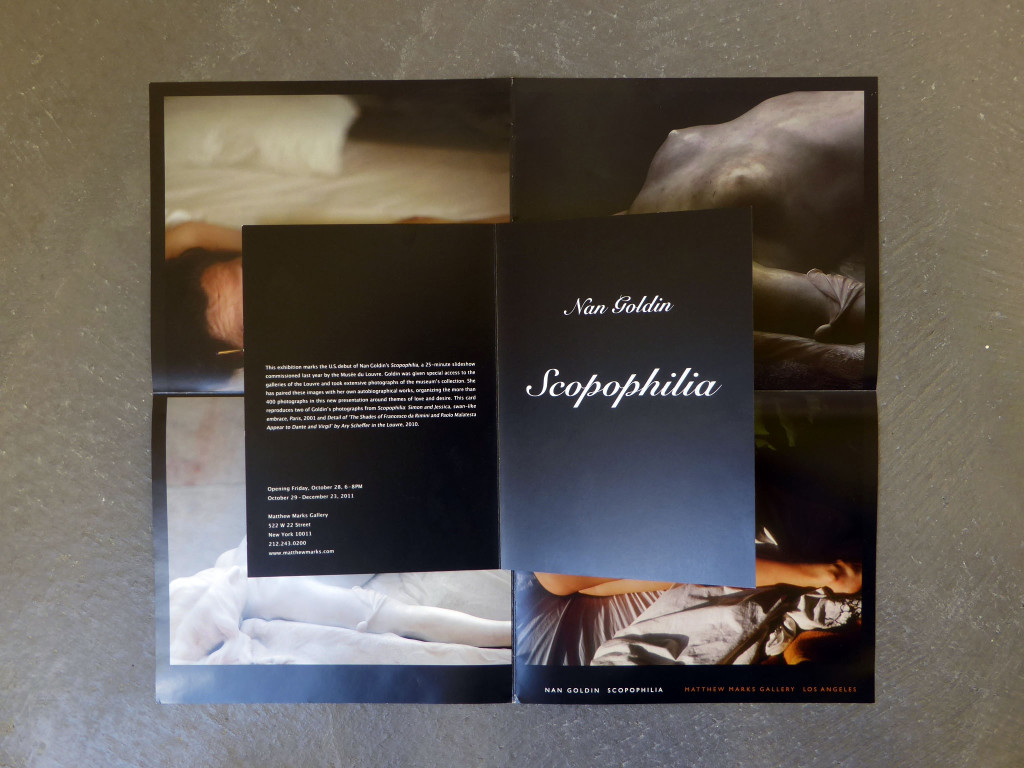
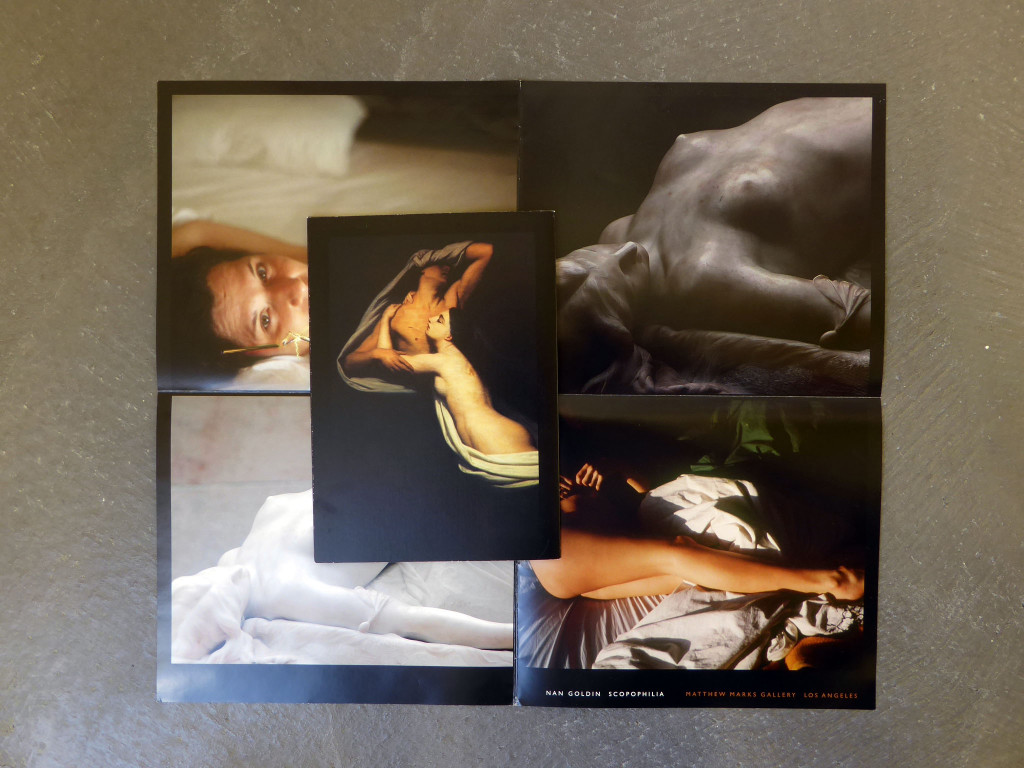
Invitation card and small poster by Nan Goldin for Scopophilia at Matthew Marks in 2011.
Donald Kuspit in “Nan Goldin. Tradition Envy“: “Writing about her series “Scopophilia,” which “pairs her own autobiographical images with new photographs of paintings and sculptures from the Louvre’s collection,” Nan Golding states that “desire awoken by images is the project’s true starting point. It is about the idea of taking a picture of a sculpture or a painting in an attempt to bring it to life.” That’s all very well and nice, but the Old Master sculptures and paintings she photographs don’t need to be photographed by her — or anyone else — to be brought to life, having already lived for centuries, not just in cultural memory, but in emotional memory, for they bring enduring meanings to life, which is why they will continue to live, long after Goldin’s photographs have died, along with the people she photographs, all emotionally shallow and undesirable and unlovable — the young unlovables of the youth culture (that is, of those arrested in their emotional and cognitive development, however physically developed and sexually active they may be) — rather than imaginatively reconfigured into mythical personae.”
Peter Fischli and David Weiss
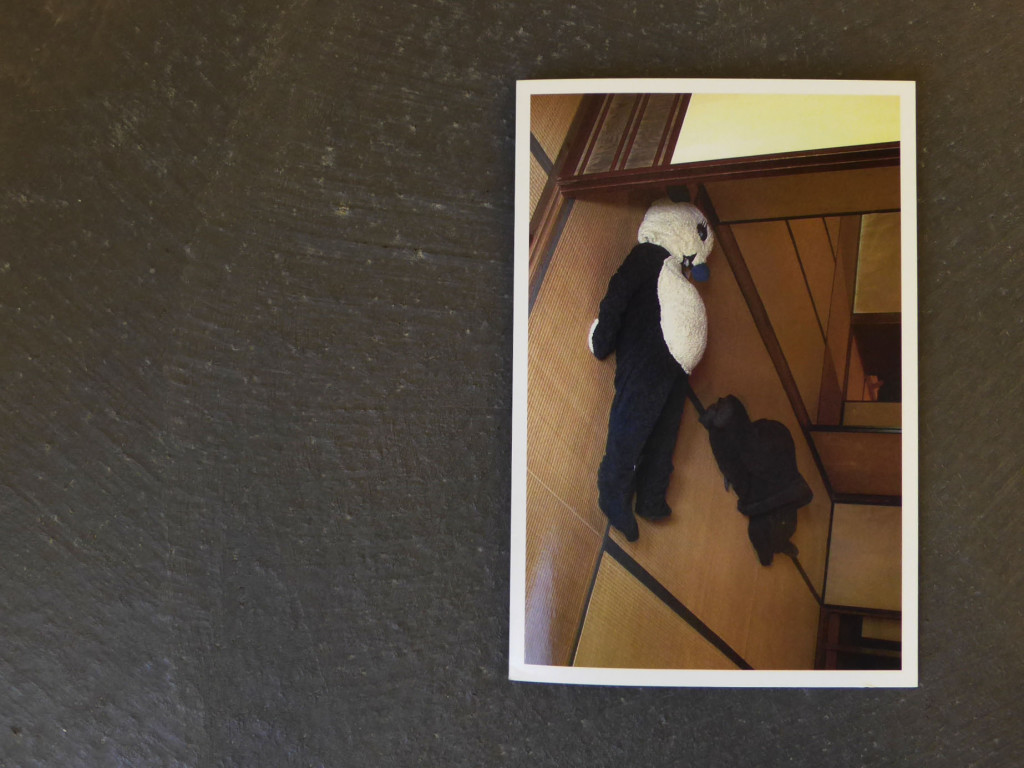
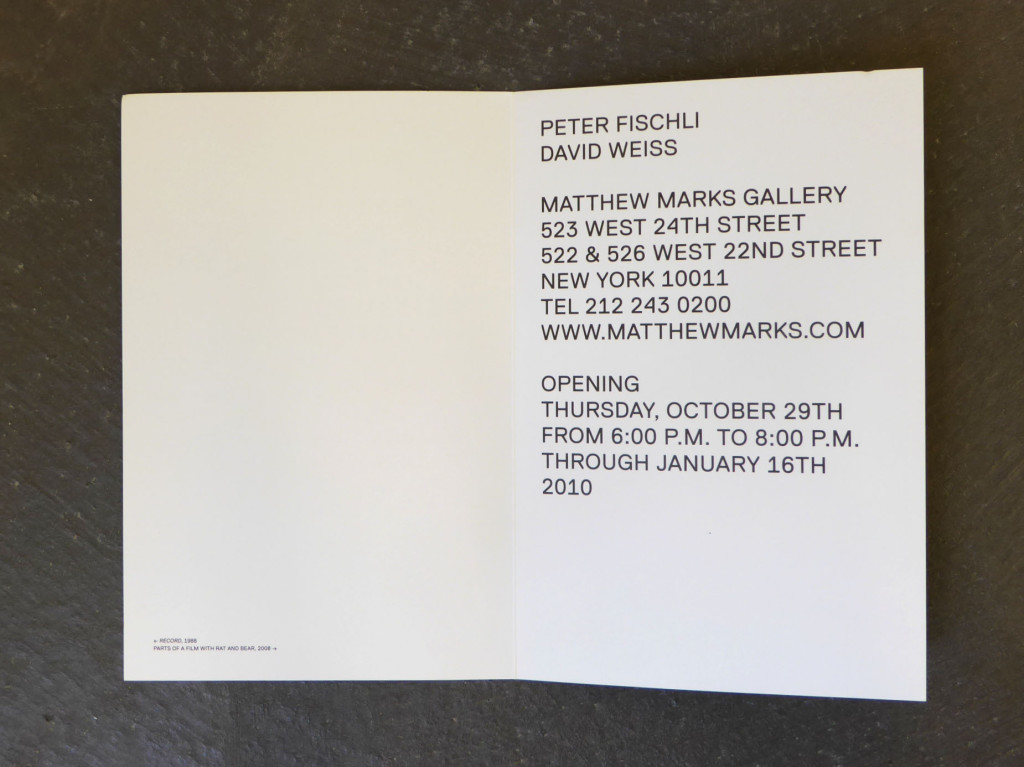
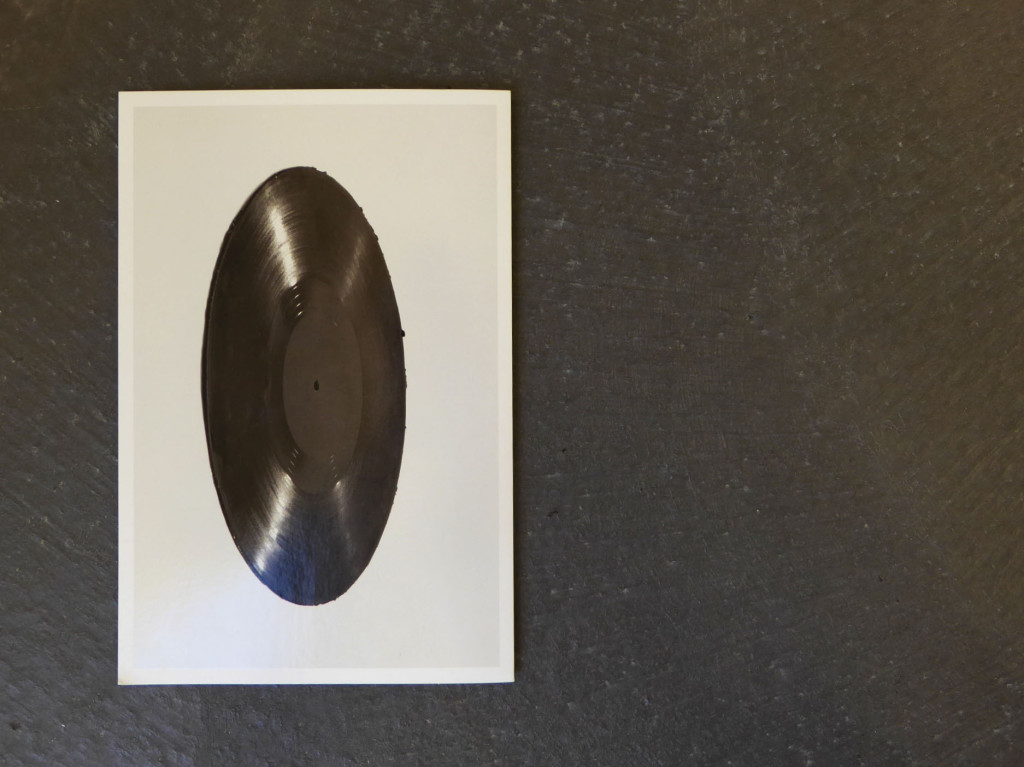
“Matthew Marks is pleased to announce a special exhibition of work by Peter Fischli and David Weiss at his three galleries. The exhibition includes the new monumental installation, Sun, Moon and Stars at 522 West 22nd Street. Clay and Rubber at 523 West 24th Street features their iconic sculptures from the past two decades in these materials, while their newest sculpture, Sleeping Puppets, will be installed at 526 West 22nd Street.” (press release)
Peter Fischli and David Weiss first show at Matthew Marks Gallery was in 1999. Before, they had shows at Galerie Stähli, Zürich (1983), Galerie Crousel-Hussenot, Paris (1984), Paris, Sonnabend Gallery, New York (1989), Galerie Walchethurm, Zürich (1992), Galerie Francesca Pia, Bern (1992), White Cube, London (1997),
Galerie Hauser & Wirth (1997), and, since 1983, at Galerie Monika Sprüth, Cologne.
Otto Sander liest Beckett
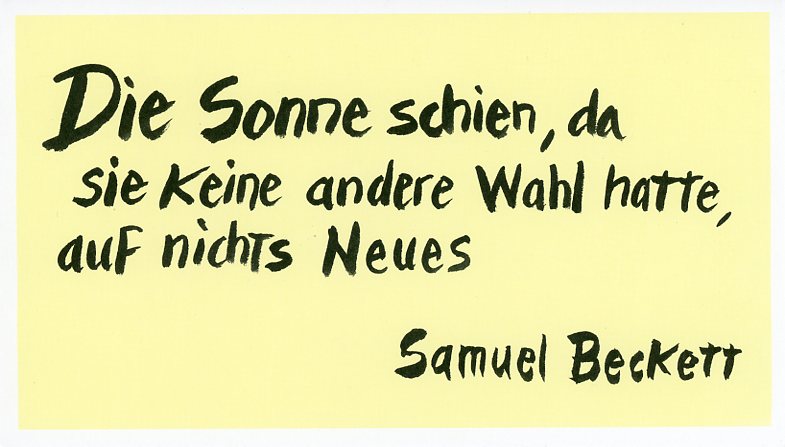
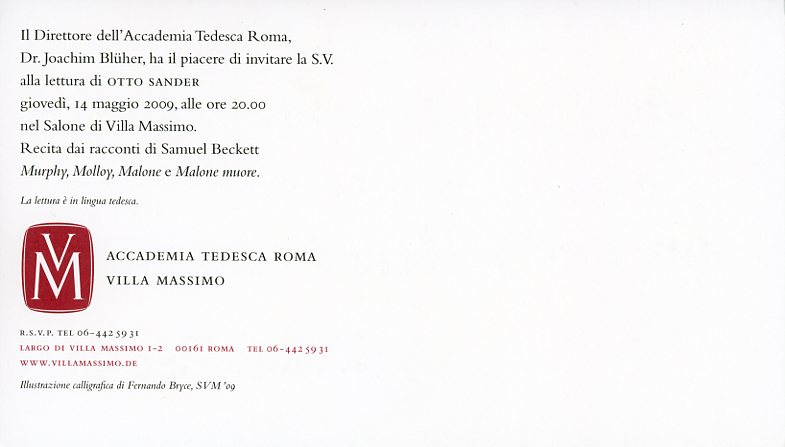
Otto Sander (1941-2013) war ein bedeutender Schauspieler (Theater und Film).
User Beitrag: “Der Satz bringt auf den Punkt, was ich mir an trostlosen Tagen denke. In simpler und fast poetischer Form Ausserdem sind Schrift und Hintergrundfarbe angenehm und passend. Die restliche Ausstellung ist wirklich interessant, fast überwältigend in ihrer Vielfalt. Gleichzeitig aber doch einheitlich in ihrer Form, sind die etlichen Einladungskarten eben”nichts Neues unter der Sonne.” Natalija L.
Darse Comfort
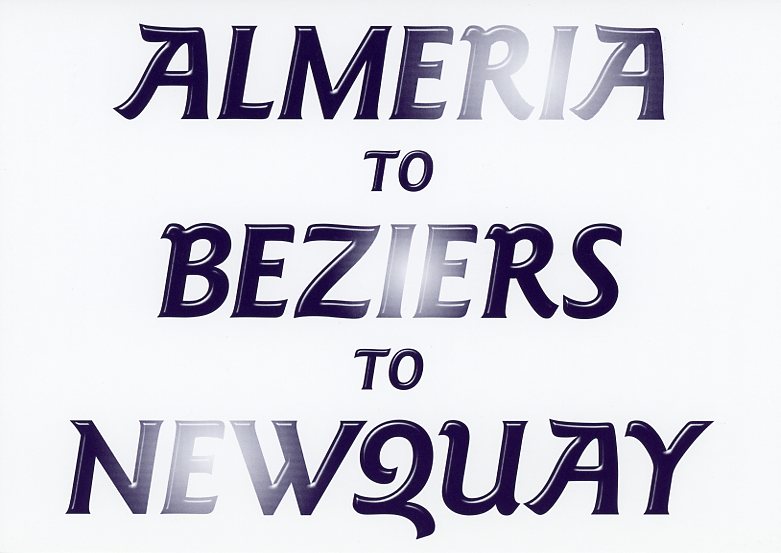
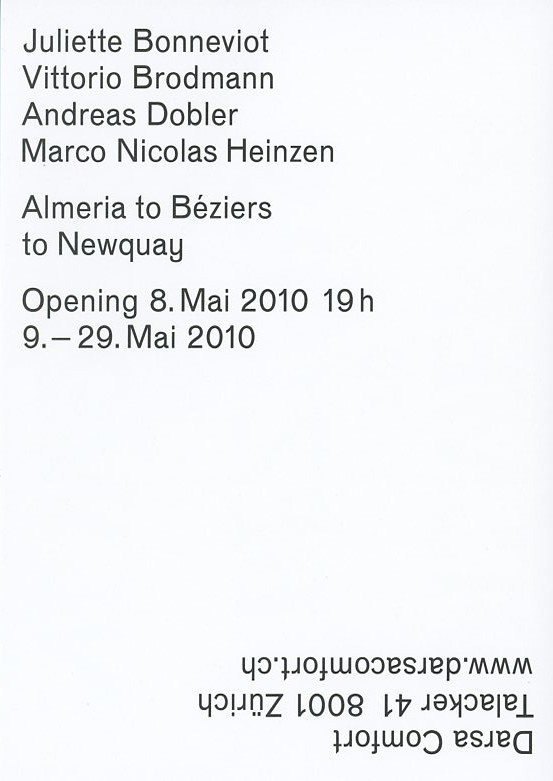
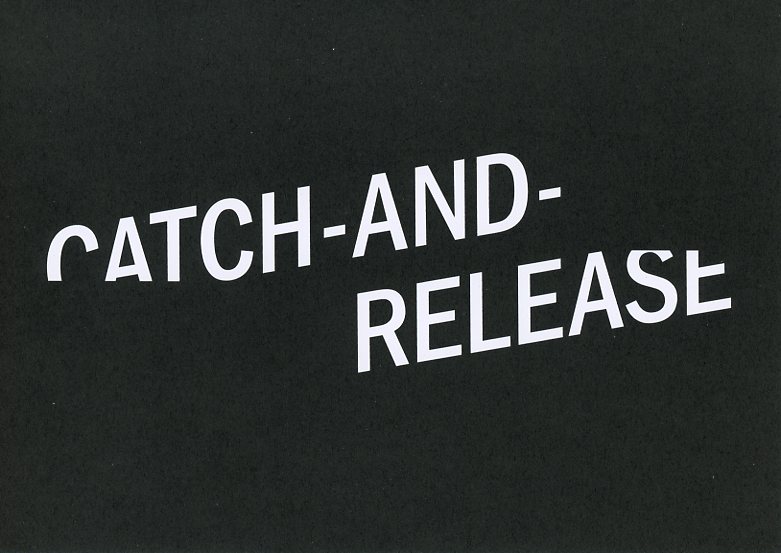
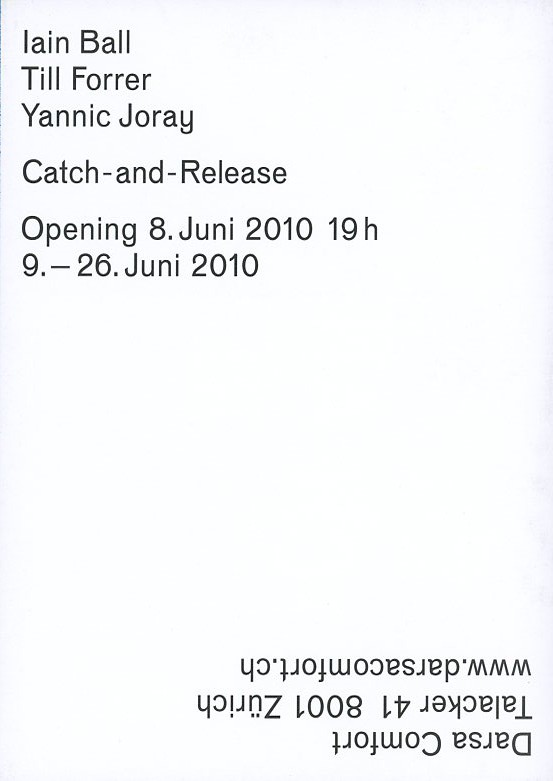
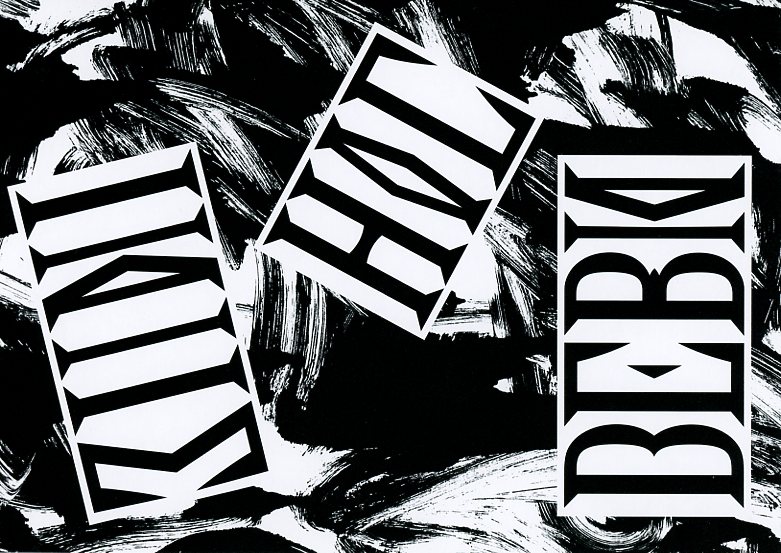
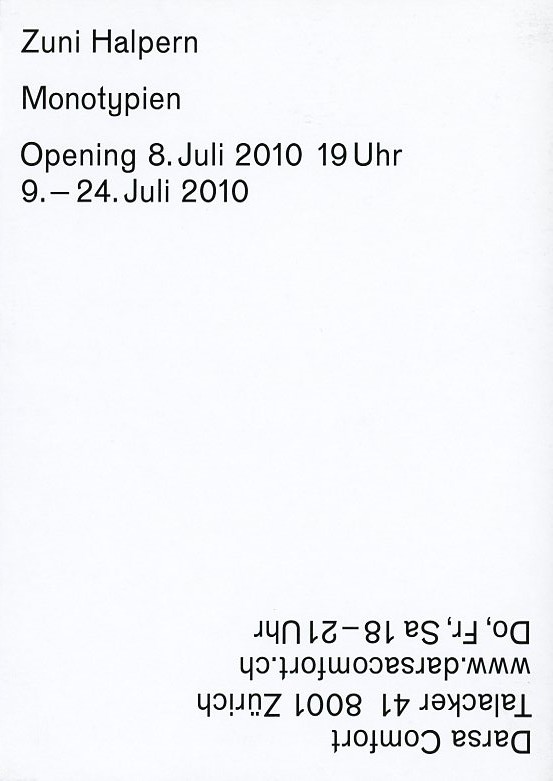
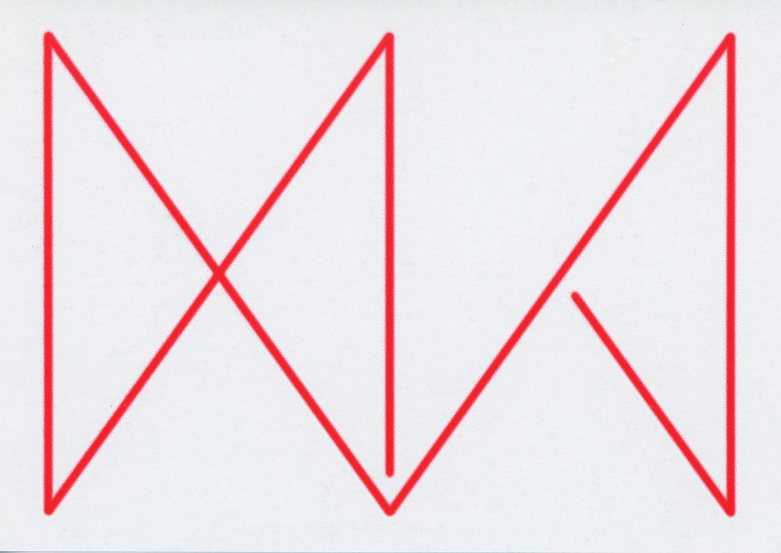
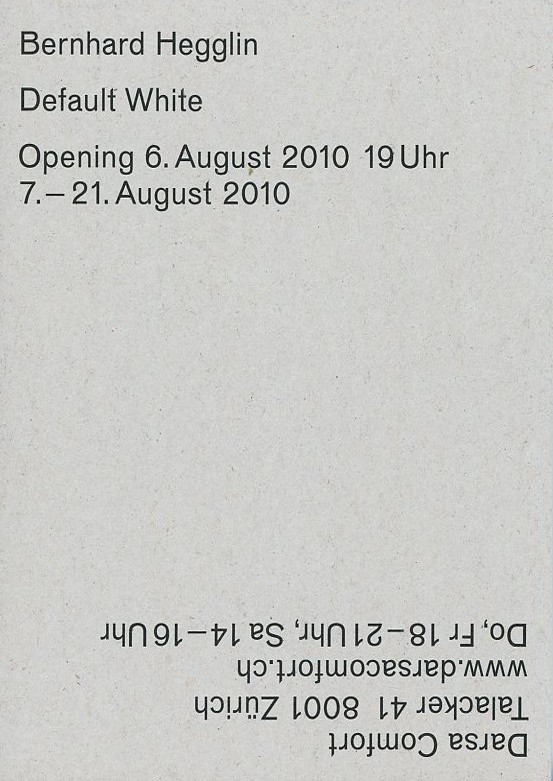
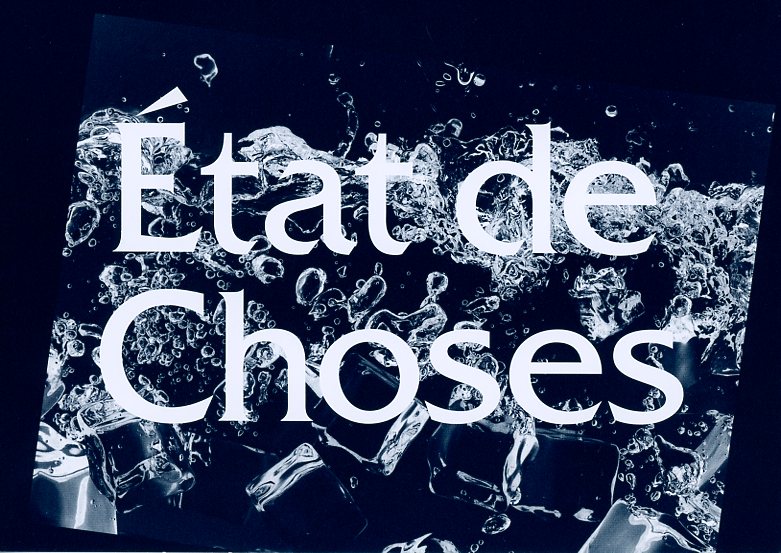
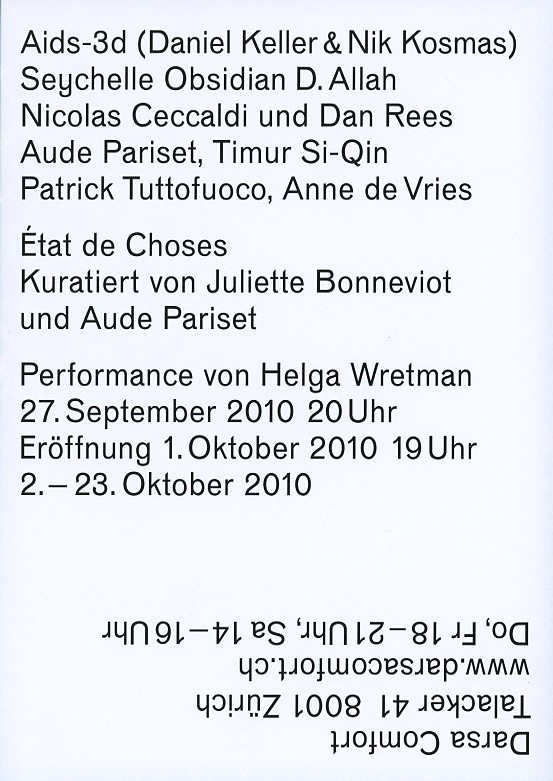
Darse Comfort was a short-lived independent art space in Zürich run by artist Yannic Joray, graphic designer Carmen Tobler, and curators Fredi Fischli and Lorenzo Bernet. Carmen Tobler was the designer of the invitation cards.
Schnittraum / Anja Sopic
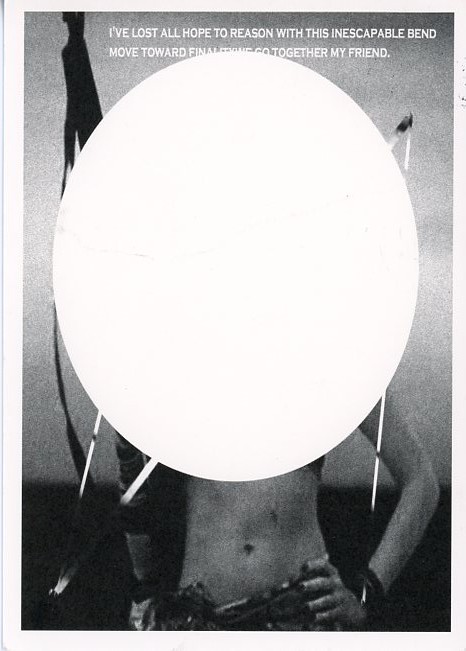
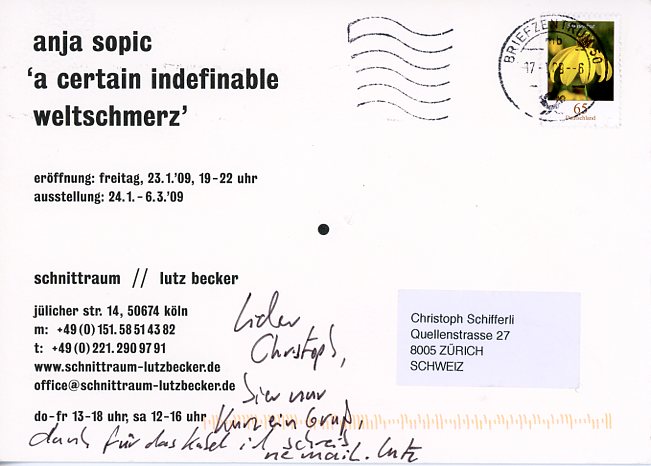
in 1997, with a grant to rent a studio space, German artist Corinna Schmitt decided to open an exhibition space instead (not far from the central train station in Cologne). From 1998 to 2000, the curators Yilmaz Dziewior, Anette Freudenberger and Maria Anna Tappeiner joined the team. In 2001, a new team of curators took over (see below). In 2007 Schnittraum turned into a gallery and was run by Lutz Becker until 2009. The exhibition by Anja Sopic must have been one of the last shows.
“Der schnittraum wurde im Juni 1997 gegründet. Mit Hilfe eines Atelierstipendiums der Düsseldorfer Firma North Property Consulting mietete die Künstlerin Corinna Schnitt anstelle eines Ateliers Ausstellungsräume in der Nähe des Kölner Hauptbahnhofes an. Von Sommer 1998 bis Dezember 2000 beteiligten sich die KunsthistorikerInnen Yilmaz Dziewior, Anette Freudenberger und Maria Anna Tappeiner an der Konzeption und Durchführung des Ausstellungsprogramms. Über 30 Ausstellungen und Projekte wurden bisher realisiert. Außerdem wurden Film- und Videoprogramme vorgestellt sowie eine mehrwöchige Projektreihe mit Vorträgen, Performances und Filmvorführungen unter dem Titel SCHNITT AM SAMSTAG durchgeführt. In der Reihe STUDIO 2000 wurden letztes Jahr fünf internationale Künstlerinnen und Künstler eingeladen, den Schnitt Ausstellungsraum als Atelier zu nutzen. Im Anschluss an den Aufenthalt wurde ihre Arbeit in Form von Vorträgen, Präsentationen oder anderen Formen öffentlich gemacht. Mit dem über mehrere Wochen angelegten Ausstellungsprojekt OUT OF SPACE war der Schnitt Ausstellungsraum im Frühjahr 2000 zu Gast im Kölnischen Kunstverein.
2001 hat sich das Kuratorenteam des Schnitt Ausstellungsraums neu formiert: Neben Corinna Schnitt und Maria Anna Tappeiner betreuten dieses Jahr Rosanne Altstatt (geb. USA) und Marjorie Jongbloed (geb. NL) das Programm. Mit JOINT VENTURES und VIDEO AB ACHT wurden zwei neue Projektreihen durchgeführt.
2002 hat sich der Schnittraum noch weiter gegenüber Außenimpulsen geöffnet. In der Reihe TONIGHT – Werkgespräche werden von Corinna Schnitt und Maria Tappeiner vermehrt GastkuratorInnen eingeladen sowie eigenständige Projekte von Künstlergruppen und Einzelpersonen durchgeführt (z.B. Wochenend von Marc Hartmann und Saskia Paul).
Im März 2003 wurde der schnittraum von Sabine Oelze und Lutz Becker übernommen und bis 2006 als nicht-kommerzielles Ausstellungsprojekt geführt.
Von 2007-2009 wurde der Schnittraum unter Leitung von Lutz Becker zur Galerie. Nähere Infos unter www.schnittraum-lutzbecker.de.” Quelle
Stefan Altenburger
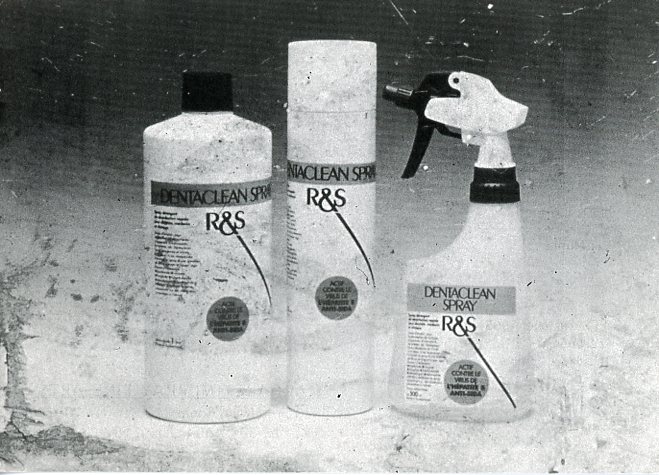
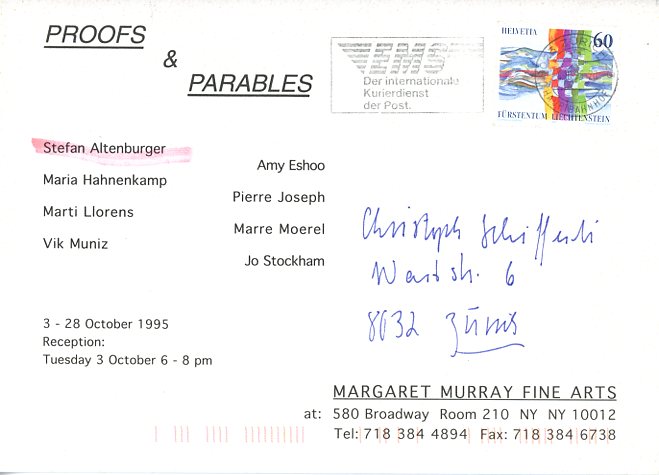
Stefan Altenburger most probably sent this invitation card to Christoph Schifferli announcing his new show in New York at Margaret Murray Fine Arts. Murray later run Murray Guy Gallery, which closed the doors of its Chelsea gallery in 2017 after 19 years of exhibitions.
Stefan Banz (1961-2021) on Altenburger: “Like Percy Rainford, Stefan Altenburger is a master of precision and restraint. He puts himself entirely at the service of the subject matter and does everything in his power to do photographic justice to the character and presence of a work of art.” Source
Today, Stefan Altenburger is an established photographer documenting exhibitions and artworks for numerous galleries, museums, and artists. If you google his name, this information shows on wikipedia: “Stefan Altenburger (Zürich, 1968) is a Swiss visual artist who is best known as musician Golden Boy for his collaborations with Miss Kittin such as the club hit “Rippin Kittin.”[1]
The Moderne Institute
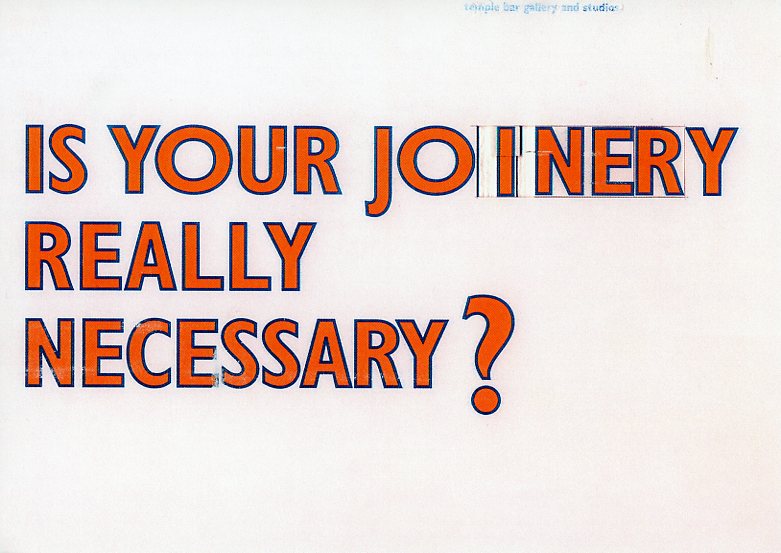
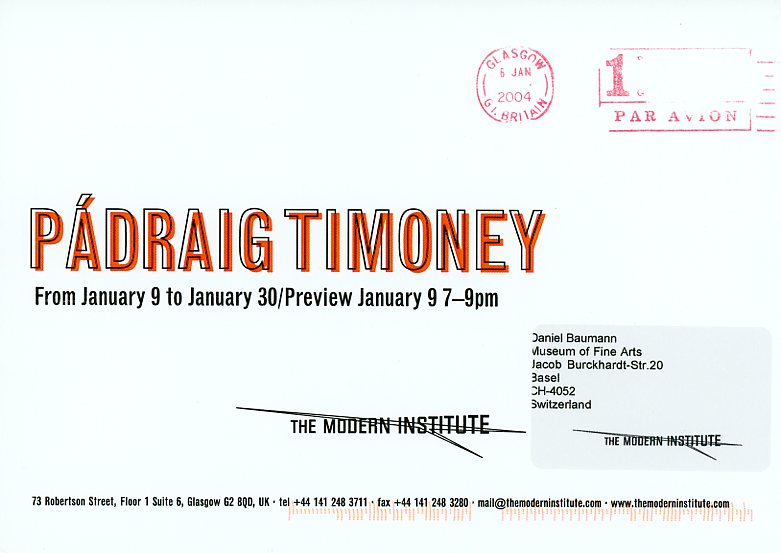
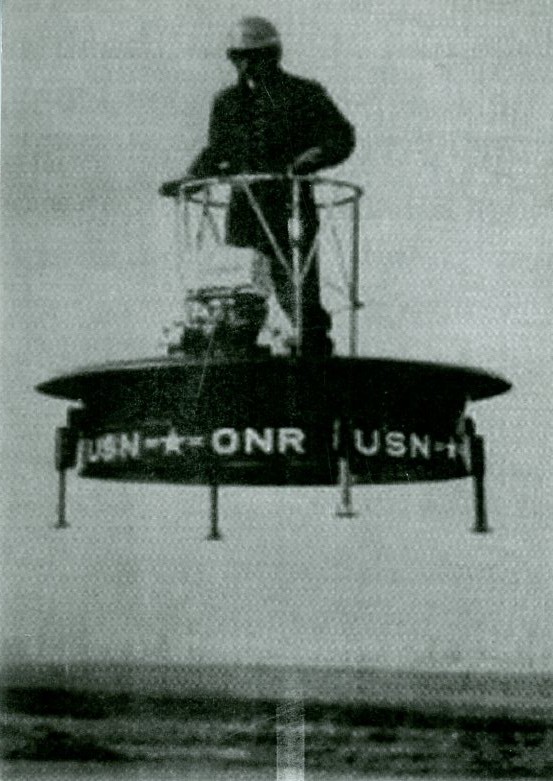
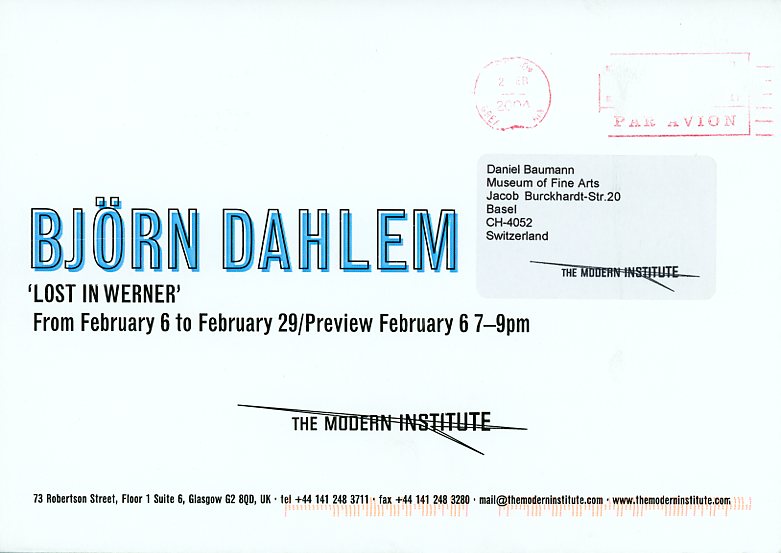
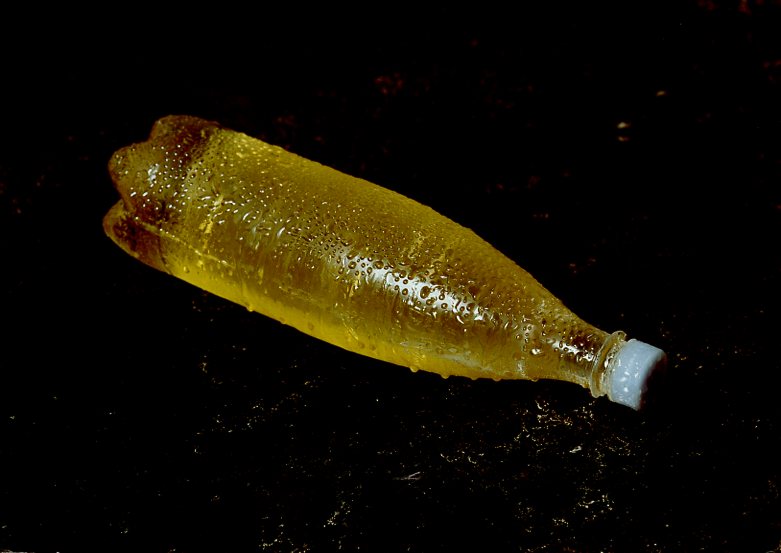
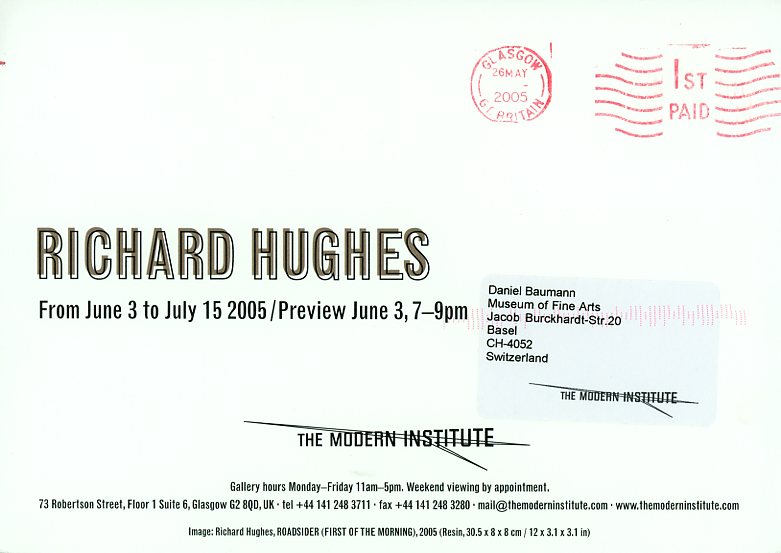
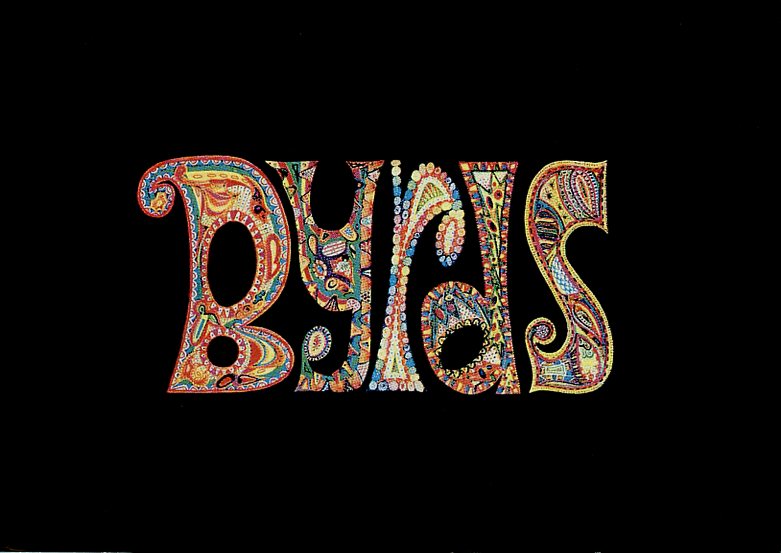
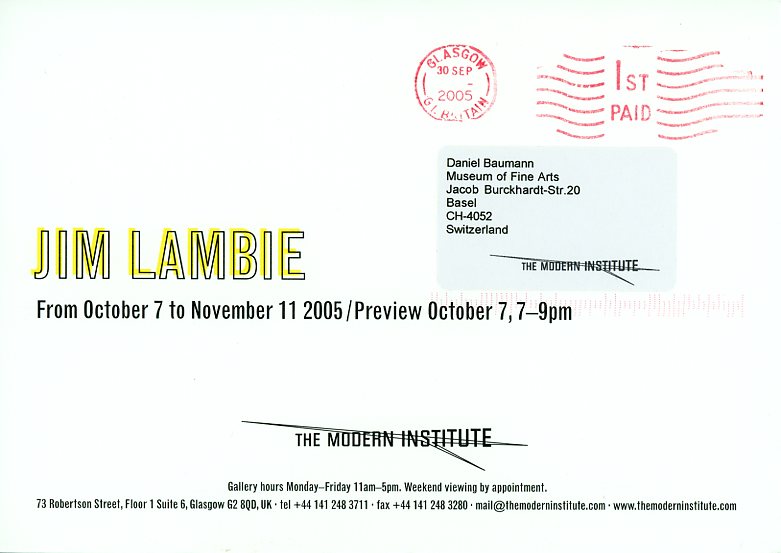
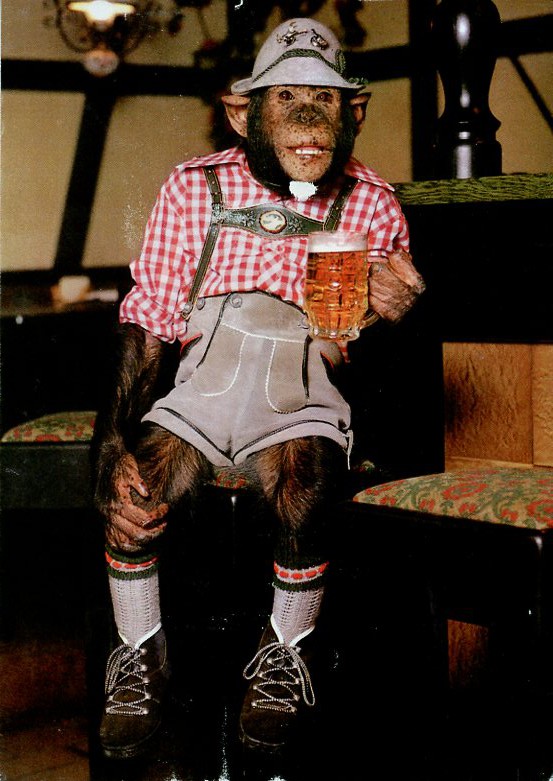
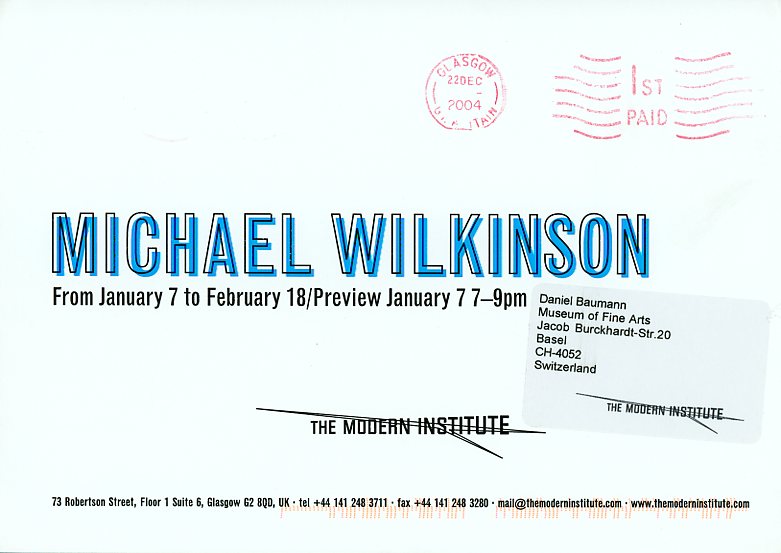
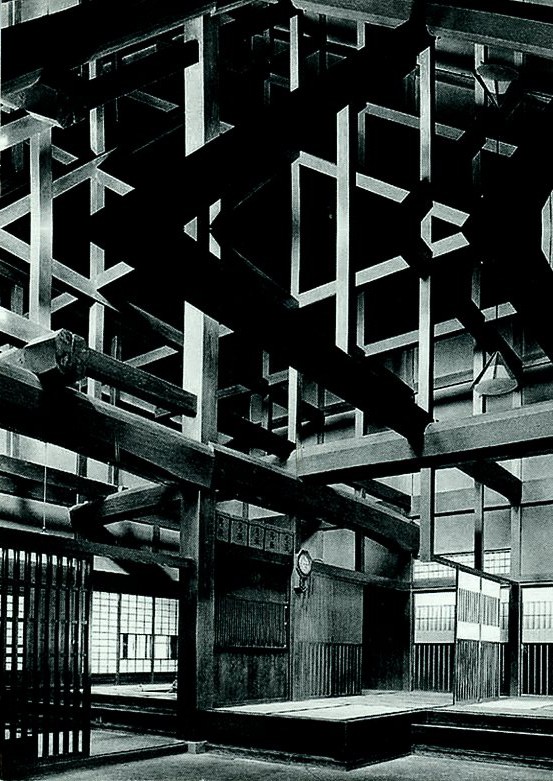
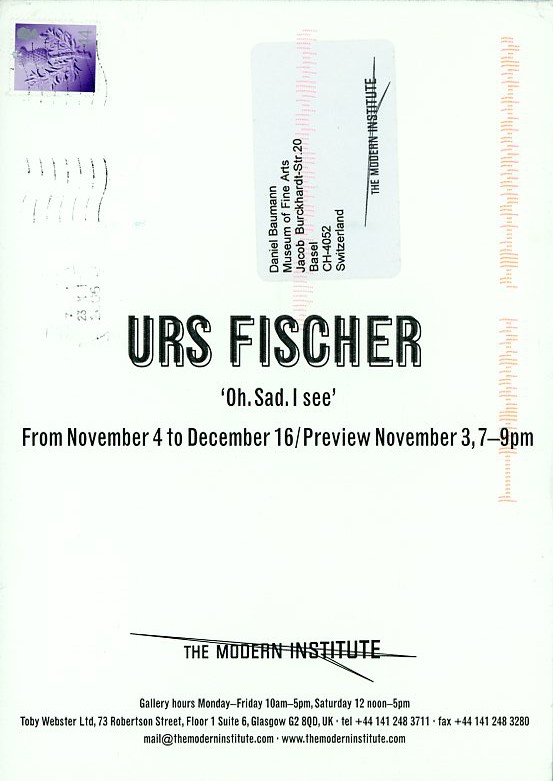
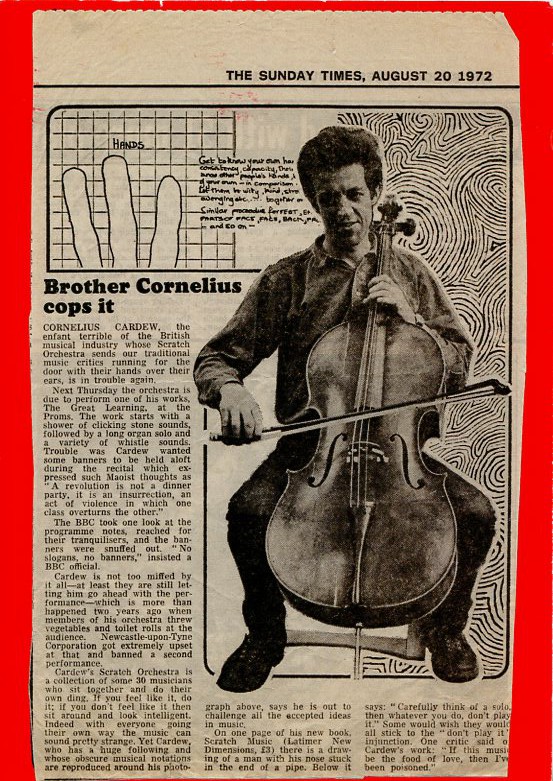
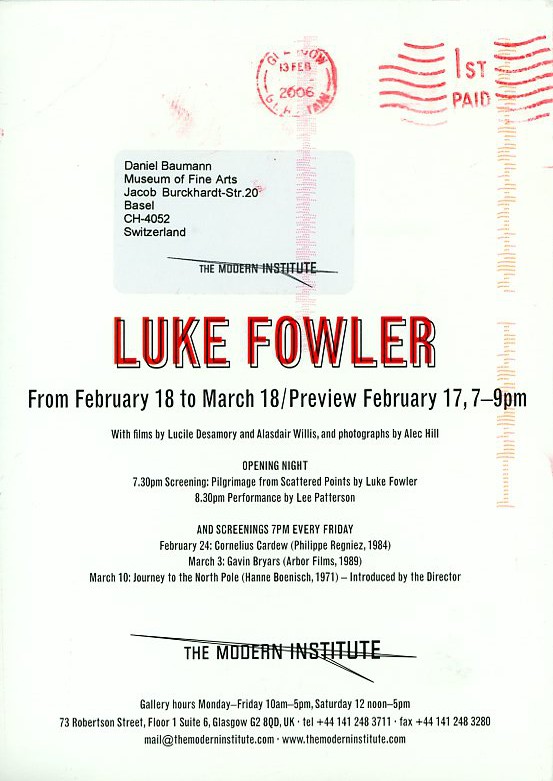
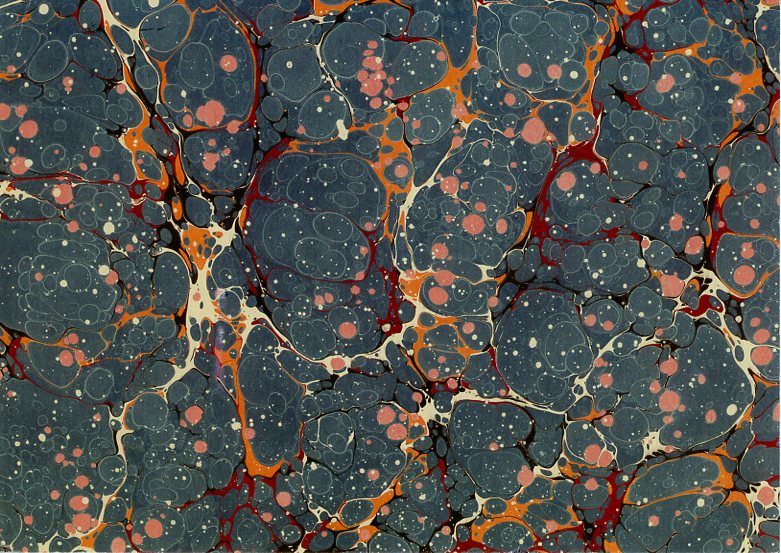
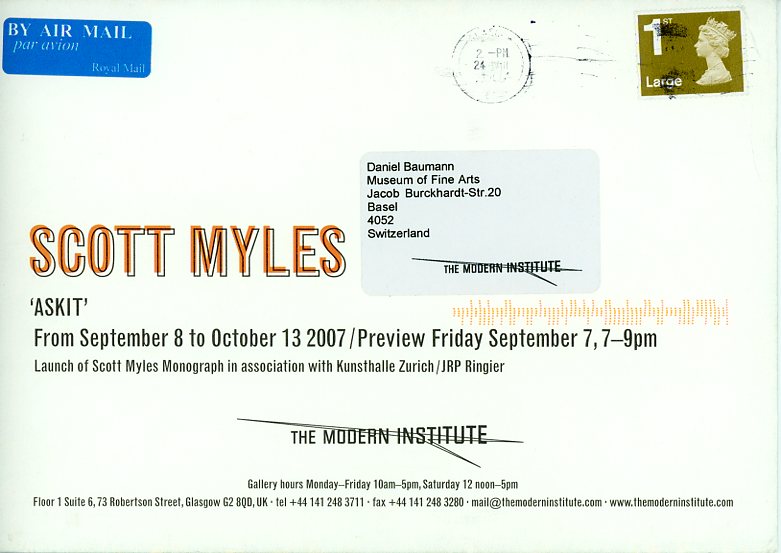
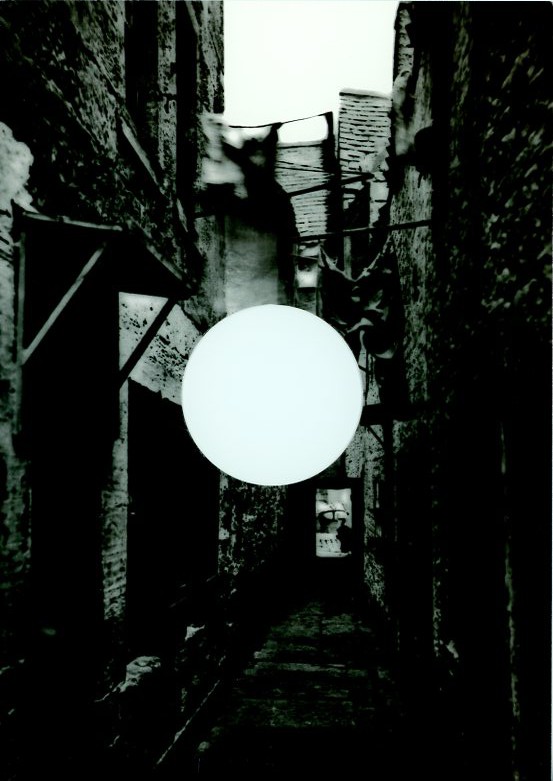
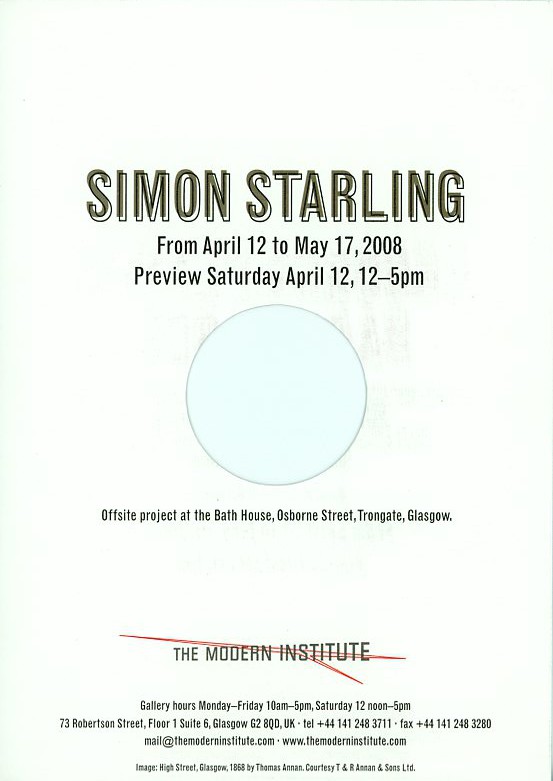
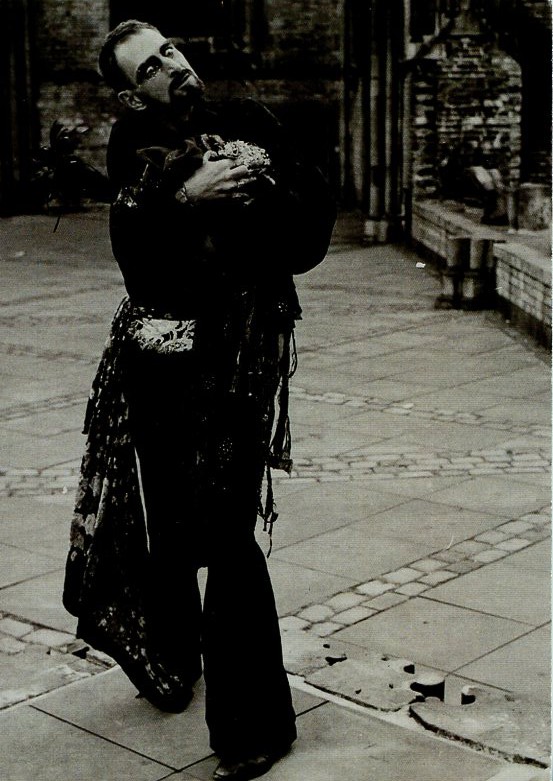
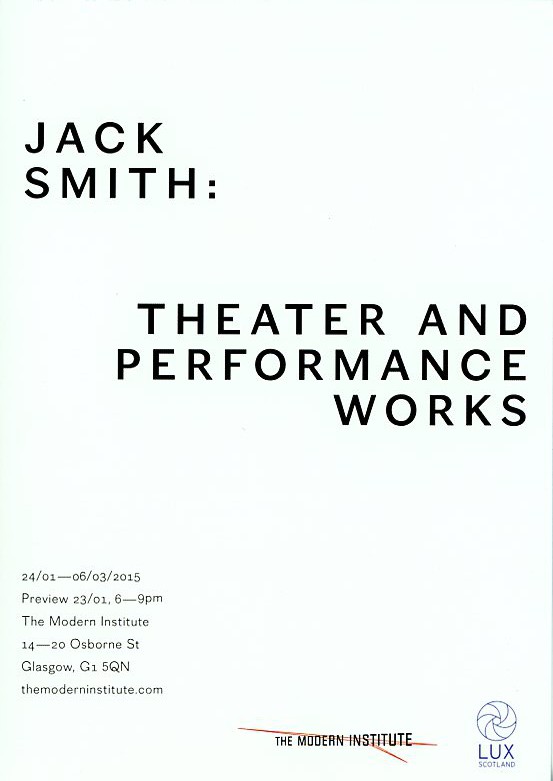
A small selection of the invitation cards by The Modern Institute. Toby Webster established The Modern Institute in 1997 in Glasgow, in partnership with former Tramway and current Van Abbemuseum Director, Charles Esche, and writer and curator Will Bradley. For many years, The Modern Institute sent out these very simple, great, sometimes funny, sometimes conceptual announcements. The gallery’s logo was designed by Toby Webster, so were the cards, and in the very beginning, he hand fed them through a riso machine. As Matthew Marks’ invitation cards, they deserve a retrospective or being part of a design museum. Or both.
As many of the new young galleries established in the mid to late nineties, The Modern Institute (est. 1997) used their invitation cards to highlight individuality and as an innovative form of (self-)branding. Invitation cards could become an art project, and a space where art may happen – and is distributed worldwide for free. A similar strategy was adopted by other young up-and-coming galleries such as neugerriemschneider, Berlin (est. 1994), Gavin Brown’s Enterprise, New York (1994-2020), CFA Contemporary Fine Arts, Berlin (est. 1992), The Modern Institute, Glasgow (est. 1997), Meyer Riegger Galerie (est. 1997 in Karlsruhe, since 2008 also in Berlin) or Eva Presenhuber (Galerie Walcheturm 1989-1998/Galerie Eva Presenhuber).
Rirkrit Tiravanija, Glasgow 1999
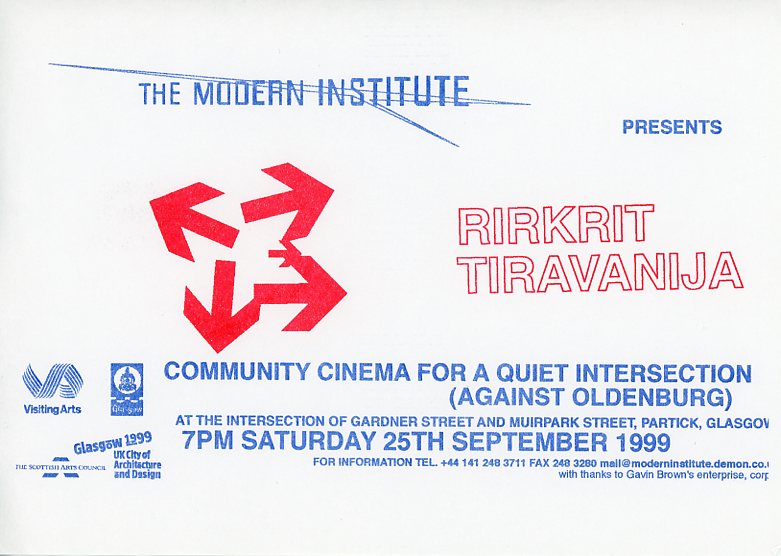
Community Cinema For a Quiet Intersection (Against Oldenburg) was an early, community-driven project by Rikrit Tiravanjia in Glasgow 1999. Here some pictures on flickr.
“The Thai artist Rikrit Tiravanja created the installation Community Cinema For a Quiet Intersection (Against Oldenburg) as part of the City of Architecture Festival in Glasgow, Scotland, in September 1999. He created a temporary outdoor cinema composed by four screens and accompanied by a Thai café right on the traffic intersection in a residential neighbourhood in Glasgow and after dusk showed films that had been chosen by the local community: Casablanca, A Bug’s Life, The Jungle Book and It’s a Wonderful Life were shown in parallel on the our screens.” Anna Schober, The Cinema Makers: Public Life and the Exhibition of Difference in South-Eastern and Central Europe Since the 1960s .
Building Modern Bodies. The Art of Bodybuilding
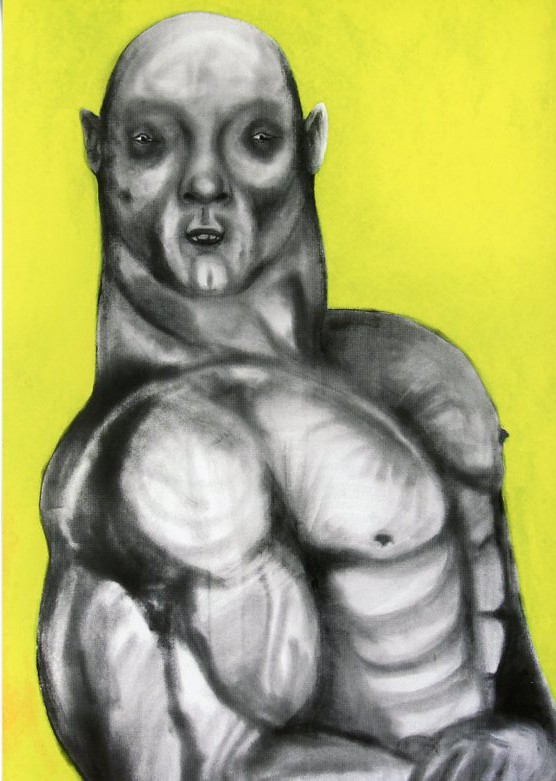
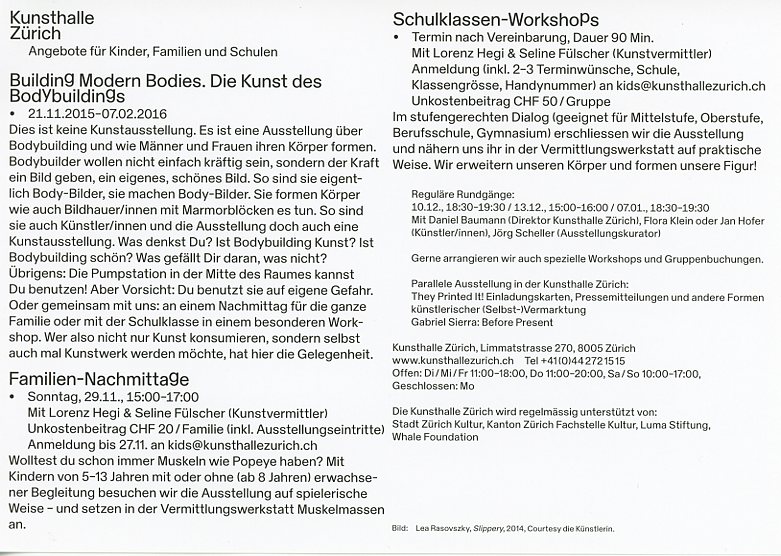
An announcement for Building Modern Bodies. The Art of Bodybuilding, an exhibition about bodybuilding curated by Jörg Scheller at Kunsthalle Zürich in 2016.
Forde, Genève
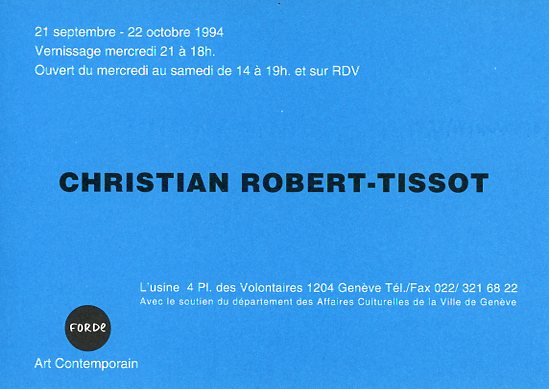
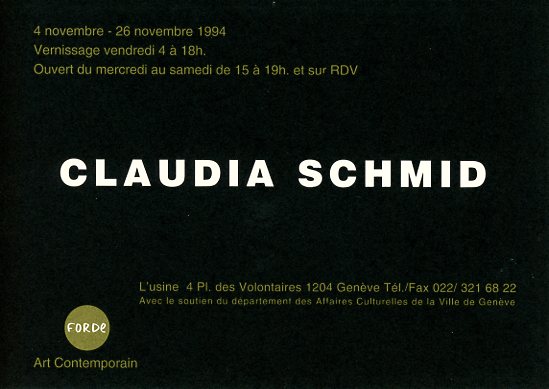
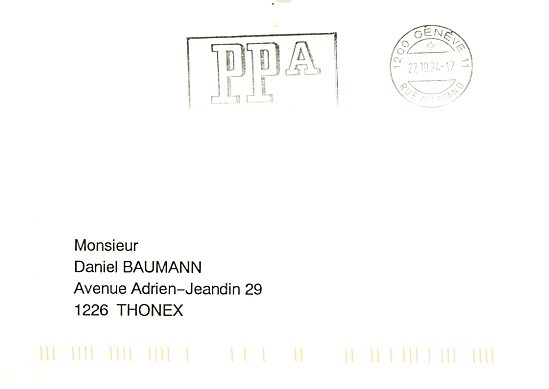
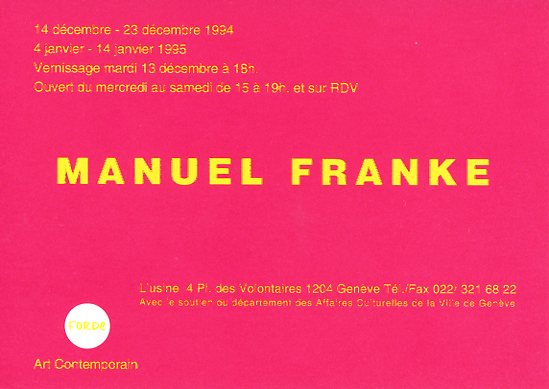
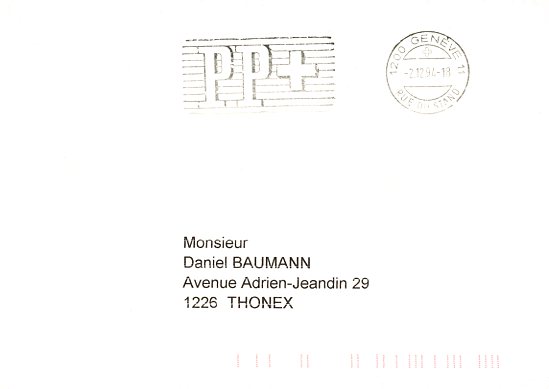
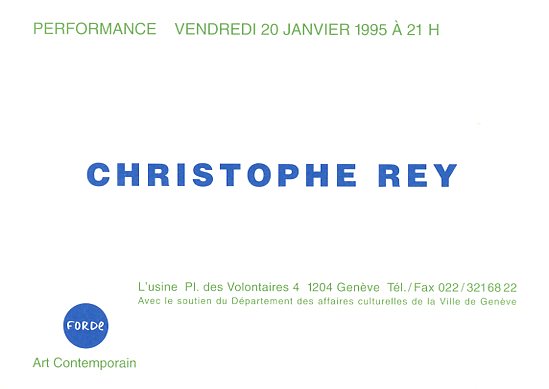
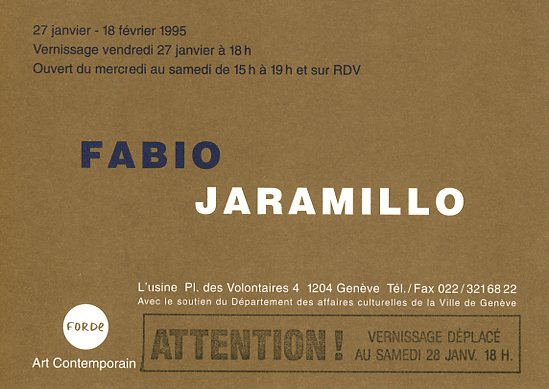
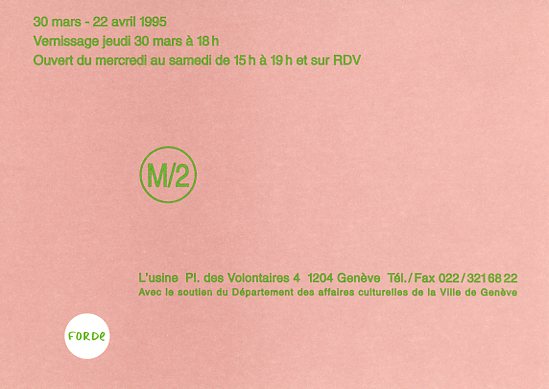
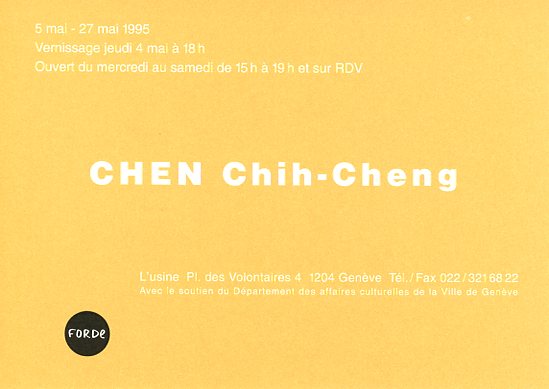
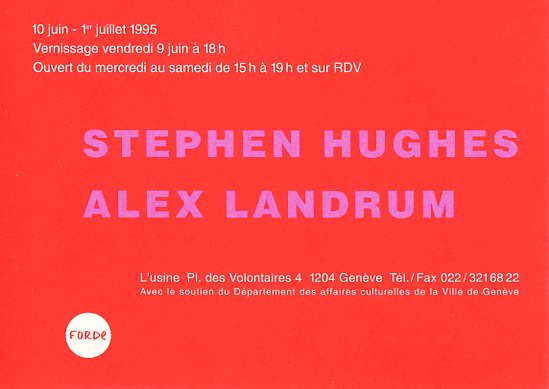
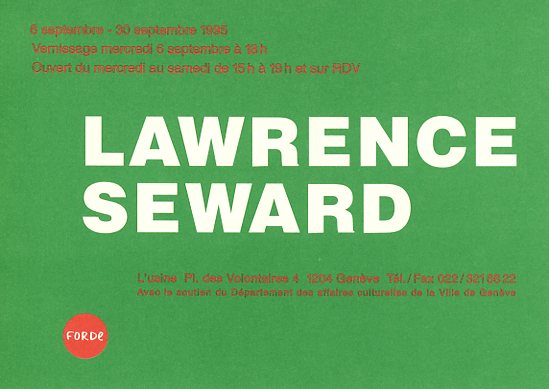
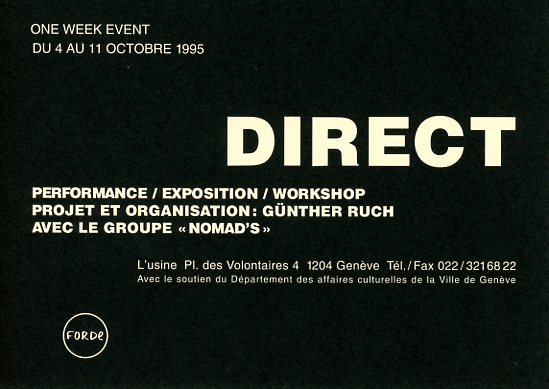
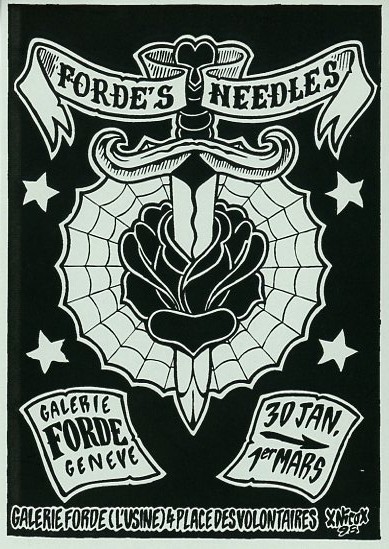
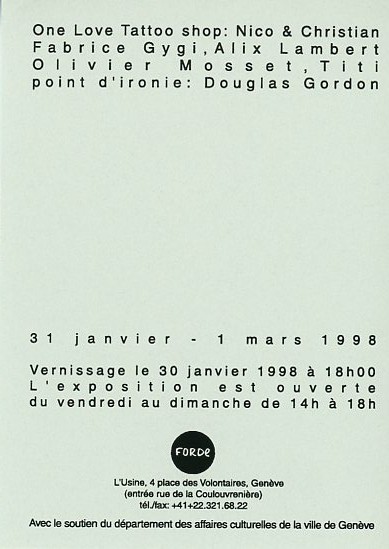
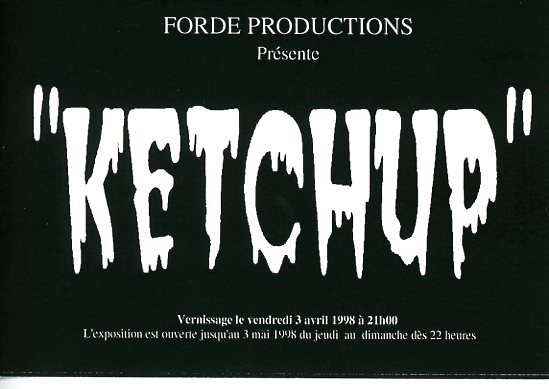
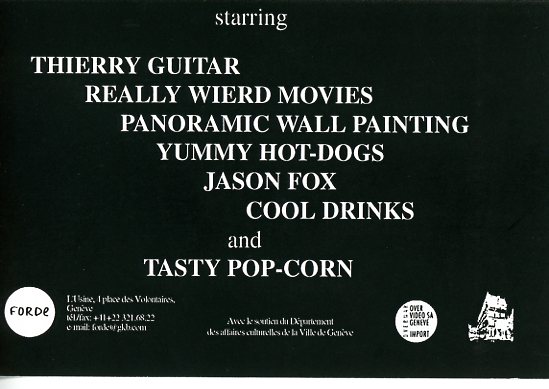
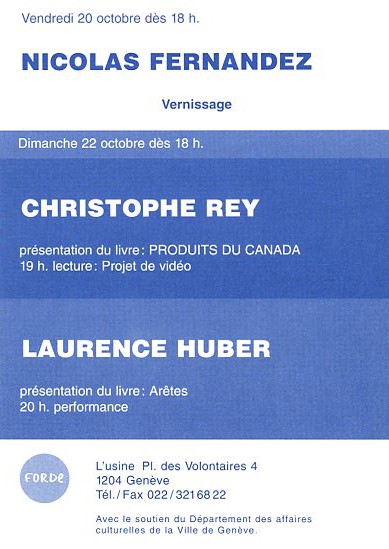
Invitation cards of Forde, an independent art space in Geneva. The cards are from the very first years, as far as I know they were designed by Geneva artist Alexandre Bianchini. Forde was founded in 1995 by the artists Alexandre Bianchini, Fabrice Gygi and Nicolas Rieben. Every three years, a new curatorial team takes over the space at Usine, here is the full list.
 follow
follow